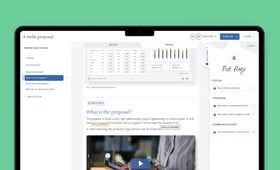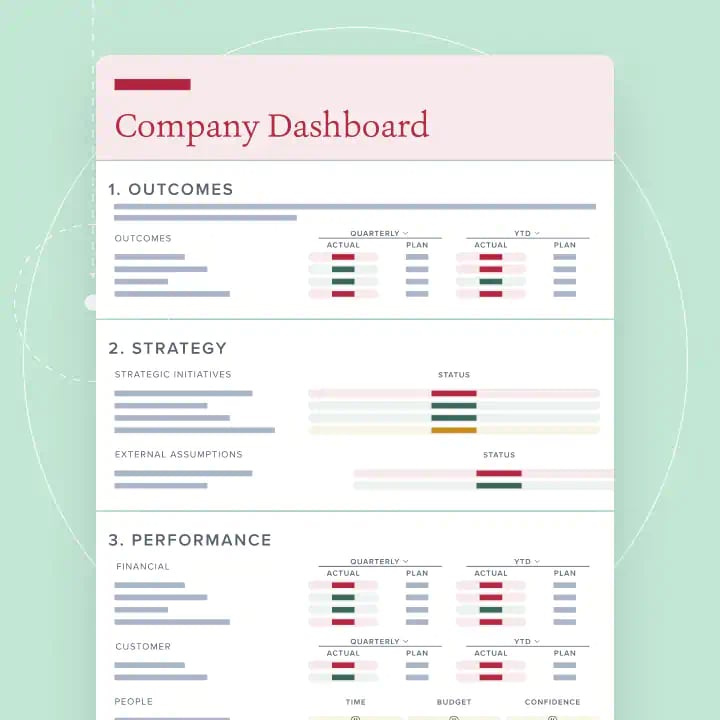If there’s one thing boards like—and need—it’s data. But striking a balance can be difficult. Give them too much or too little data, and they might miss an important insight, get stuck in the weeds, or make an uninformed decision.
To strike the right balance, you need to ensure that your board pack includes a high-quality KPI (Key Performance Indicator) dashboard. But what does a best practice KPI dashboard look like, and how do you build one?
Read on for our top tips for producing an excellent company KPI dashboard for your board. Or, if you’re short on time, watch our quick video guide instead.
What is a KPI dashboard and why do boards need them?
A KPI dashboard provides a visual summary of an organization’s performance and outlook. It brings together a variety of carefully selected metrics to give directors an “at-a-glance” view of the organization’s health. It’s usually one of the first reports a director reads when they open their board pack. It sits alongside the CEO’s report and ideally fits on a single page.
When it’s done correctly, the KPI dashboard cuts through the noise and helps directors focus their attention, experience, and time on the most important issues. It provides a “single source of truth”, ensuring that the organization’s leaders are on the same page when assessing the business’s health and critical metrics.
However, too few directors see this benefit, as they’re overwhelmed with information. The average board pack is now 226 pages long (up more than 30% since 2019) and 54% of directors struggle to find the key messages in them. This is according to research conducted by Board Intelligence and the Chartered Governance Institute UK & Ireland. A director once compared reading their board pack to “drinking water from a fire hose” as the data was so detailed and dense.
A KPI dashboard is a highly effective way to address this information overload, condensing a potentially limitless supply of data points into actionable, board-relevant insights.
How do you build a great KPI dashboard?
Most dashboards focus on short-term financial and operational metrics; 62% of directors think that the management information they’re given is too operational and not strategic enough.
To present a holistic picture of the organization’s health, you need to consider a wide variety of factors, such as finance and operations, sustainability, stakeholder relationships, and customer satisfaction.
But selecting the right metrics, when there are so many to choose from, can be a challenge. How do you build a KPI dashboard that covers all the bases? How do you decide what to include, and what to omit?
Here are our top tips for best practice KPI dashboards.
Align your KPIs to your value creation story
Many organizations are drowning in data. It’s easy to end up with 10 pages or more of numbers, graphs, and charts, from what’s required by regulators, to the “just in case” bits and pieces.
We suggest using a different tactic. Put your current KPIs to one side and start with your value creation story instead.
Identify the main outcomes you’re trying to achieve as an organization (essentially, the reason it exists) and thoroughly understand how you deliver those outcomes to create value. All the metrics you include in your dashboard should stem from, and speak directly to, this collection of high-level goals.
Set the bar high when working out what matters
Framing your dashboard around a core list of high-level outcomes isn’t enough to prevent information overload. Each item could bring its own complex set of leading indicators and performance metrics, running to many pages.
To produce an effective dashboard, think of it as the tip of your organization’s information pyramid, containing only the highest-level metrics. The dashboard isn’t the place to drill into the details. It’s there to help directors scan the full horizon and work out what to focus on.
To do that, keep it to one page.* We believe this is possible even in the largest and most complex organizations. By keeping your dashboard to a single page, you set a high bar for the data you’re presenting, helping you avoid “information for information’s sake”. It also encourages greater discipline and focus by pushing management to think critically about what to include and, importantly, what to leave out. The result is a clear, shared understanding of what matters, what will help the business meet its goals, and the metrics that show whether your plans are working.
Frame the data around questions. Use questions as headings and present the metrics that best (and most directly) answer them. For example, rather than having “financial performance” as a section heading, ask “Did we meet our financial goals?”. Ultimately, data doesn’t drive insight, but questions do. Read on for the four key questions we think you need to answer in your KPI dashboard. You can also use the Question-Driven Insight (QDI) Principle to work out your own.
*Additional detail, if required, can be covered by functional or business line reports (which can include their own dashboards) or go into an appendix.
Check for data blind spots and blurred lines
Once you’ve identified the right questions and metrics, ensure that you’re not leaving any risky gaps or clouding the picture. Structure your data to make sure it covers all the bases, with nothing muddled or missing.
Use “mutually exclusive and collectively exhaustive” metric groupings to make sure you’re painting the full picture. This means covering financial and non-financial metrics, internal and external factors, and providing a forward-looking view as well as looking backwards.
The dashboard should also cover the high-level themes that help the board deliver its remit:
- Strategy: Its progress towards long-term goals.
- Performance: Results achieved in the last period and how well the forward plan is being delivered.
- Governance: The way in which the organization’s activity is conducted (some measure of retaining your license to operate, either regulatory or reputational)
We also recommend keeping data and narrative separate. A dashboard is ideally accompanied by a separate narrative (at a maximum of three pages) explaining where performance excelled or lagged, and the implications of this. The report is typically written by the Chief Executive and sets the scene for the board meeting.
What 4 questions should your company's KPI dashboard answer?
Questions are critical to deciding what should be included in your dashboard. Here are four questions that can help you present a holistic picture of your organization’s performance and deliver the insights your directors need.
1. Are we delivering our ambition?
Here, you should provide two to five metrics that evidence your commercial ambition and your company's higher purpose. These metrics define the reason why you’re in business. Include your principal measure of commercial value, for example, profit or return on capital, then your purpose. What matters to your stakeholders? How do you measure the impact you promise to them?
2. Is our strategy on track to deliver long-term goals?
This is about strategy execution, which you can demonstrate by reporting on the progress of key programs and initiatives. Important to note here: less is more.
Are the programs on time, on budget, and delivering the benefits that you intended? What could potentially knock your results or strategy off track? These factors typically include economic market trends and societal or political forces.
3. Are the in-year drivers of performance healthy?
These indicators provide assurance that you’re delivering short-term results. They’re also the levers that management can pull to change the course of your ambition. Typically, they straddle product, customer, operations, and innovation. They include your cash position and sources of income to ensure that you can fund that ambition.
4. Are we working in the right way?
You could be excelling at your ambition, strategy projects, and short-term KPIs. But does this come at a price? Are corners being cut? Are you damaging your long-term reputation?
Think about the following two sub-questions:
- What could threaten your license to operate? Regulatory, societal, or climate concerns?
- What does it mean to do business in the right way? Here, you can cover topics such as risk, governance, and culture.
Once you’ve considered these questions, you can select metrics that answer them. As you do this, remember to consider metrics that have predictive power, and some that are externally reported. This balance ensures that your dashboard won’t be too insular or backward-looking.
How can Board Intelligence help you create best practice KPI dashboards?
KPI dashboards are an important tool for boards, but they need to be designed, built, and implemented in the right way in order to add value to board discussions and decisions.
With so many stakeholders and moving parts involved, it can be a challenge. That’s where Board Intelligence can help. With our Dashboard Development service, we can do the heavy lifting for you.
We’ll work with you and your board to create and implement a custom KPI dashboard built on proven methodology, 20 years’ experience, and industry best practice. We can help you transform information overload into actionable insight that unlocks your board’s full potential.
The catalyst of saying ‘what is the data we need to support both our performance and our strategy’ leads to a very robust debate . . . and ultimately you get a much better quality of discussion and decision as a board.”
Charles Gurassa, Chair, Channel 4 — read the case study



